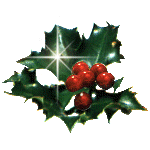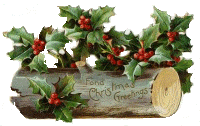|
The Traditions of Christmas
|

Christmas Carols

Not all songs that we sing at Christmas time are carols. Most
songs sung in church or by church choirs are actually hymns.
Centuries ago, a carol was a group dance accompanied by a
joyful song. Gradually it came to mean the song itself. A carol
became a happy melody that anyone could sing. Caroling
still means singing songs of joy, but more than that it means singing the
beautiful songs about the most joyous news that men have ever heard.
The word "carol" comes from the
Greek and means a dance done
in a ring, or music for round dancing. By the 14th Century,
the medieval church frowned on such frivolity, and the carol
melodies began to be used as religious tunes, with the
words changing to reflect the new usage. Carols
were used throughout the year to celebrate not only Christmas,
but other holy days, as well as changing seasons and
secular festivals. By the 15th Century, the use of carols in
Christian worship declined as church music became more serious.
It was the Victorians, with their interest in parlor singing, who
began looking for cheerful, easily sung music to be used in their
Christmas celebrations. Musicians began collecting old nativity
carols as well as writing new ones to be sung at Christmas. Two
notable collections were "A Good Christmas Box" in 1847 and
"Christmas Carols Ancient and Modern" in 1871.
The tradition of caroling from door to door grew out of
the waits, an ancient English custom of traveling from house to
house and singing in exchange for food. Outdoor carol singing
became very popular in both England and America during the late
1800s and early 1900s. "Here We Come a-Wassailing" describes the
tradition of the waits.
When the Victorians wrote new words to old carols and new
songs about Christmas, carols began to reflect a religious theme
and began to be used in church services. References to making music
abound in Christmas carols asking that pipes, drums, bells and voices
be raised in celebration and worship.
Our favorite Christmas carols were either written or revised
during the Victorian era. The list includes "O Little Town of Bethlehem",
"Good Christian Men Rejoice", "Silent Night", "It Came Upon a
Midnight Clear", "Away in a Manger", "We Three Kings"
and "Jingle Bells." We owe the Victorians a debt of
gratitude for their contribution to the music that's such an
important part of our Christmas celebration today.
|
click below for
Christmas Carol Lyrics
|

Holly

The holly leaves and berries
from the
holly bush are widely used in holiday
decorations. The sharp pointy edges of
the holly leaf remind us of the crown of
thorns that Jesus wore upon his brow.
The red berries remind us of the blood
that Jesus shed.
|
|

The
Candy Cane

The candy cane represents one
of the
oldest symbols of Christmas, the
shepherd's crook, for the shepherds
were among the first to experience that
first Christmas. The colors of the candy
cane have special meaning, too. The
wide red stripe represents the sacrifice
of Christ, "For by his stripes we are
healed." The narrow red stripes
represent our own sacrifices (giving).
The white stripe is a symbol of purity.
The peppermint plant is a member of
the hyssop family, referred to in the Old
Testament as a medicinal herb used for
cleansing. As you eat your candy cane,
you might want to break it, as Christ's
body was broken for you, and share it
with a friend, thus sharing in the
sweetness of the true meaning of
Christmas.
- or -
In the late 1800's a candy
maker in Indiana wanted to express the meaning
of Christmas through a symbol made of candy. He came up with the idea of bending
one of his white candy sticks into the shape of a Candy Cane. He incorporated
several symbols of Christ's love and sacrifice through the Candy Cane.
First, he used a plain white peppermint stick.
The color white symbolizes the purity and sinless nature of Jesus.
Next, he added three small stripes to symbolize the pain
inflicted upon Jesus before His death on the cross.
There are three of them to represent the Holy Trinity.
He added a bold stripe to represent the blood Jesus shed for mankind.
When looked at with the crook on top, it looks like a
shepherd's staff because Jesus is the shepherd of man.
If you turn it upside down, it becomes the letter J symbolizing
the first letter in Jesus' name.
The candy maker made these candy canes for Christmas,
so everyone would remember what Christmas is all about.
|

Yule
Log

"Yuletide" for
"Christmastime" is a term derived from the yule log ,
which in olden days was a huge log used as the foundation
of the holiday fires. Bringing the yule log in was, as recently as the 19th century,
as much a part of the pre-Christmas festivities as putting up an evergreen tree today.
"Yule" can be traced back to the Middle English "Yollen" (cry aloud)
and is thought to date from early Anglo-Saxon revels in celebration of the discovery
after the winter solstice) that nights were becoming shorter.
Up until the 19th century, the custom of burning the Yule log flourished in
England, France, Germany and among the South Slavs. Out of oak, families
carved a heavy, wood block. They placed it into the floor of their hearth.
It glowed throughout the year under the flames of household fires.
Gradually it became ash.
|

|
Back to the Top
Christmas
:: Going Home :: Christmas Stories
Giving Gifts :: Santa Claus :: Decorating I
Decorating II :: Traditions I :: Traditions II
Birth of Christ
Home || Spring || Summer || Autumn || Winter
St. Patrick's Day || April Fool's Day || Easter || Mother's Day
Memorial Day || Father's Day || Independence Day || Friendship Day
Labor Day || Back to School || Grandparent's Day || Columbus Day
Halloween || Election & Return Day ||
Veteran's Day
|| Thanksgiving
Christmas || Hanukkah || Nutcracker Ballet || Secret Santa 2002
New Year's Day || Martin Luther King, Jr ||
Kwanzaa
Groundhog Day || Valentine's Day || President's Day || Mardi Gras
Arbor Day || Happy Birthday || Webrings || Awards || Flag Day
January || February || March || April || [May || June || July
August || September || October || November || December
|

Updated:
January 07, 2006
©GrannyDancer Productions, 1999-2006
all rights reserved
Disable right
click
by Renigade
Underline remover
|
|